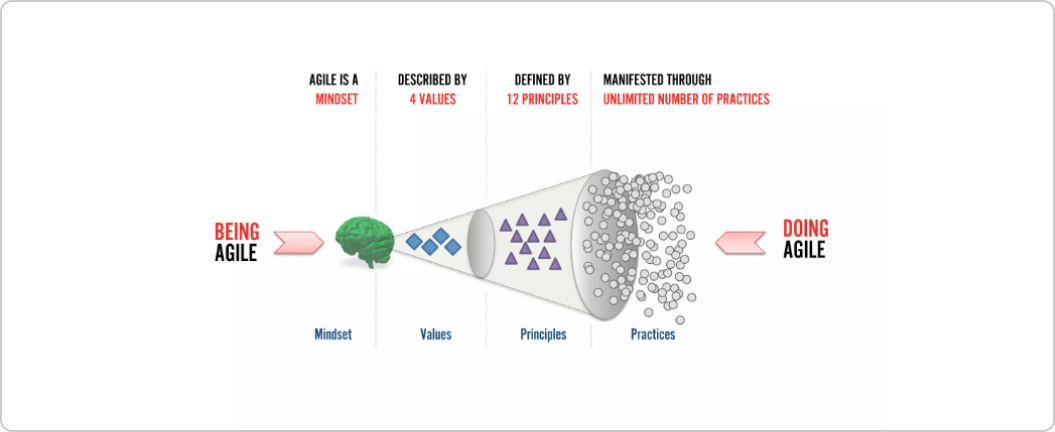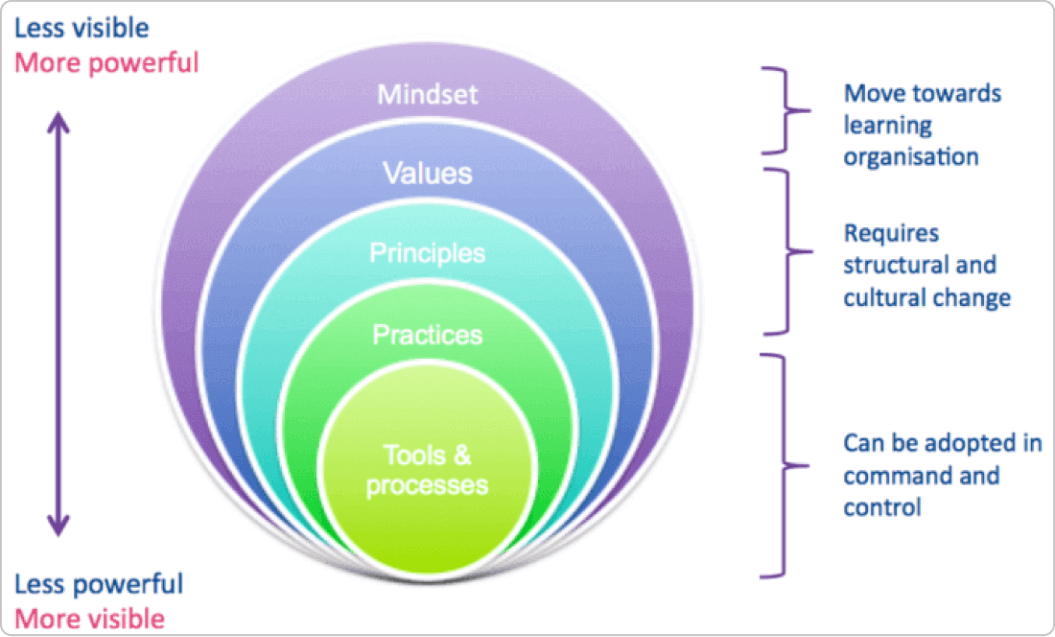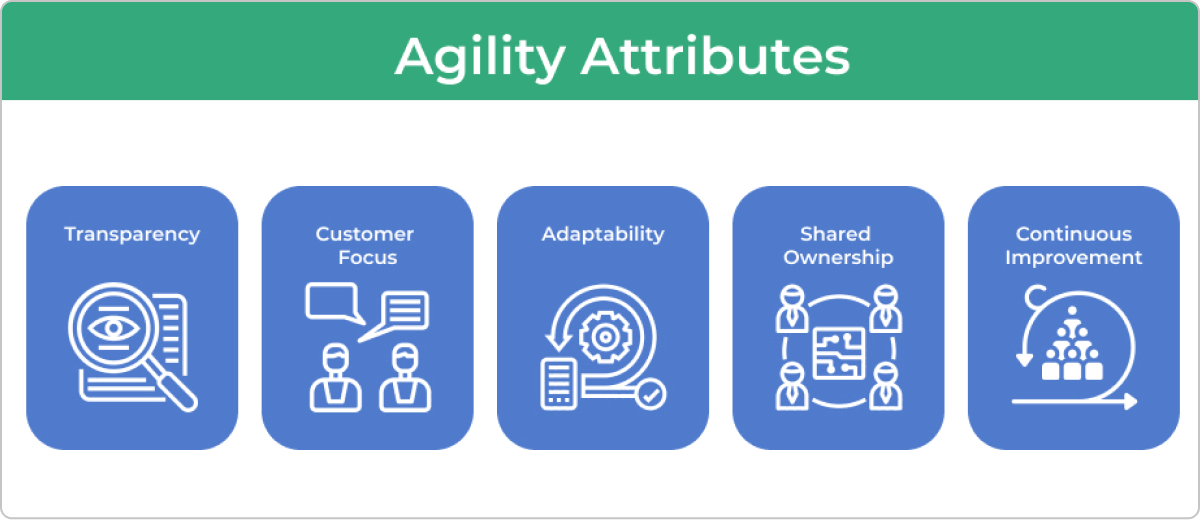What Is an Agile Mindset?
The Agile mindset is a set of beliefs, viewpoints, and attitudes that allow teams to become more flexible and adaptable to changes. Agile thinking promotes collaboration, knowledge sharing, and feedback exchange, allowing organizations to focus on creating value and improving continuously.
By definition, a mindset is "a person's way of thinking and opinions."
Therefore, an Agile mindset is this internal predisposition that shifts your behavior, so collaboration, iterative execution, customer value, and experimentation become natural first choices. Once you switch to Agile thinking, you are on your true path to agility and into the infinite game of continuously adapting and advancing.
A common misconception about Agile is related to focusing only on what frameworks or methods will work for us. And while everybody eventually reaches that point, a quick glimpse at the Agile Manifesto reminds us that the important part has always been the mindset.
 The Agile mindset: image by Ahmed Sidky
The Agile mindset: image by Ahmed Sidky
The manifesto itself talks about values and principles, giving guidelines and priorities that will lead you to agility. What exactly you do daily and how you decide to manifest those in your operations is in your own hands, depending on your needs and goals.
Agile Mindset vs. Agile Frameworks
So what happened to Agile? How did the conversation shift from asking the question “Does this make sense?” to “What is written in the guide?”.
We believe there are two powerful forces met: economic interest and the wish for a shortcut.
The short version of the story is: The Agile pioneers shared with enthusiasm the great results they achieved following the Agile principles. The rest of the business world said, "I want that too! Fast." or "Tell me what I should tell my people to do so that we can achieve these results." So the consultants and coaches adapted to this new market need.
As we know, supply follows demand, so it is no wonder that in the brief span of 15-20 years, over 70 different Agile frameworks emerged, and hundreds of different certification programs were launched.
So, below, let’s take a look at why:
- Frameworks are only the beginning in the ongoing process of embracing an Agile mindset
- Blindly following frameworks can lead you to do Agile without being Agile.
Frameworks as a Starting Point
It is simpler to follow the rules than to shift your mindset. It also takes much less time to introduce new rules than to create a new environment.
The goal of the newly created frameworks is to offer a shortcut to agility, and if their role is understood correctly, they can indeed do that.
It is crucial, however, to see them as a starting point, not as a silver bullet or a fast-lane ticket to business agility.
Introducing a framework, sending your employees to a course to get certified, implementing tools, hiring consultants, are all essential and necessary steps to create and train agility habits.
But this should only be the start. Simply following the steps will not magically set your mind on Agile frequency. A mindset shift requires time and effort on a personal level that is beyond any certification program.
 Using The Agile Onion to Illustrate the Agile mindset as The Most Important Layer of Adopting Agility
Using The Agile Onion to Illustrate the Agile mindset as The Most Important Layer of Adopting Agility
You can think of it as learning a foreign language. You visit a course, you pass a test, and you get your certificate. This does not automatically mean you are a fluent speaker who knows all the words in that particular language. Or that you should use only the words you learned in the course and all other words are wrong because they are not in your dictionary. It merely means you have learned the basic rules and the logic of the language, and you should continue exploring and mastering it on your own now.
The same is true when adopting agile. It is ok to start with a framework. Just do not stop there.
Thinking about it, clinging to the outlined rules of a single Agile framework is maybe the most unagile thing you can do. It is a signal of a superficial change, where you are trying a new tool in the same old environment of command and control.
Blindly sticking to a guide indicates you are fine with your comfort zone because there is a high level of certainty and a lack of ownership of the process. It shows the focus is on what you are doing instead of why you are doing it. Ignoring the "why", people start asking questions like, for example, "Is Kanban Agile?", focusing on doing Agile and not understanding the logic behind it. In fact, that's a pretty dangerous zone to be in as it leads you to ignore the needs of your own environment and apply something just because it worked for somebody else.
Frameworks as a Means to an End
Another framework-related issue occurs when Agile becomes a goal. Instead of looking at agility as a means to an end, some companies neglect their own reality and focus on what the framework suggests.
Blindly following frameworks will give limited, if any, results at all. Do not look at Agile as an exercise that you can complete. Aim at understanding the logic of an Agile mindset and how to integrate it within your business environment.
Agility as the Manifestation of the Agile Mindset
So much talk about Agile frameworks has left agility with less attention than it deserves.
By definition, agility is the ability to respond quickly to change. It is not a tool, but a character trait or behavior all Agile efforts should lead to as a result.
Agility is, in fact, the result of the Agile mindset.
What Are the 5 Agility Attributes?
The Agile manifesto itself talks about values and principles, providing guidelines on how to reach agility. By shifting the way of thinking and conducting business, the true attributes of agility become seamlessly incorporated into an Agile workflow.
-
Transparency. The Agile thinking promotes openness to share progress, ideas, challenges, and feedback, creating a safe environment where collective work is key.
-
Customer focus. Agile work delivery places a great emphasis on acknowledging customer requirements through encouraging a constant flow of feedback and collaboration
-
Adaptability. One of the most common goals of Agile transformation journeys is turning the organizational mindset to increased adaptability and building resistance to turbulent changes.
-
Sense of Ownership. Through encouraging collaboration and sharing of feedback or ideas, the Agile mindset brings team members closer to the decision-making process, making them more motivated and involved.
-
Continuous Improvement. A cornerstone of agility and the Agile mindset, continuous improvement captures the essence of what it really means to be truly Agile – to constantly reflect on past experience, learn from it and improve.
 Core agility attributes
Core agility attributes
The Finite Players vs. the Infinite Mindset
There is a very popular talk by Simon Sinek, "Be an infinite player" in which he uses the terminology of Game theory (finite and infinite game) to describe a significant difference in the current dominating business logic and new emerging business perspective.
In his words, most businesses and business leaders nowadays act and think as finite players. The finite player is playing a game with a start and an end, with a winner and a loser, defined by fixed rules and an agreed-upon objective. She is in the game to win it, to beat the competition. Although the described situation resembles a sports game more than the business world, many companies still define their objectives as "beat the competition".
However, in the new complex dynamic of our 21st-century reality, there are also businesses and business leaders that can be identified as infinite players. They are in the infinite game, where there is no real start or endpoint and where the rules are not static but changeable. It is a game you join and play to outperform yourself. The focus is on advancement. In contrast to the finite business logic, here, the objective would be to upgrade your product and continuously make it better.
How is this related to the Agile mindset?
Reducing your Agile efforts to merely following the guides of the Agile frameworks or any other of the more prescriptive Agile methodologies creates a feeling that agility is a finite game - a game with a particular objective, rules, and limitations, where you can say what is right and what is wrong.
On the other hand, developing an Agile mindset opens the door to the infinite game of agility. The aim is to play for as long as you can (or to stay in business for as long as you can) and to infinitely improve and advance, adapting yourself to the changing rules.
What kind of game do you think agility really is - finite or infinite? You need to decide for yourself.
So, to Set Your Mind or Not to Set Your Mind?
We say, set your mind.
However, a mindset is not something you learn in a course. It is the result of knowledge and experience combined with a deliberate habit of reprogramming. Train your thinking to notice specific relevant information, to ask certain questions per default, and to look in certain directions. Do not just go with the framework flow.
Like with all knowledge, the valuable part comes not from simply learning the facts but from understanding the dynamics and the logic that lies behind them. The Agile world makes no exception. Once you internalize the logic, you can apply it in various, often unexpected ways.
Aim at understanding what an Agile mindset is and how you can implement it within your operations. With the change in the way you think about Agile, agility will flourish naturally in all directions.
Businessmap is the most flexible software
to align work with company goals
In Summary
Developing an Agile mindset is more than looking up to what Agile methods and frameworks prescribe and following certain rules. It all starts with the people and to what extent you are ready to shift your beliefs to create a new environment of Agile thinking.
The ongoing process of embracing an Agile mindset starts with:
- Understanding the Agile practices, values, and principles
- Focusing on Why rather than What you are doing
- Continuously learning and improving







 Core agility attributes
Core agility attributes

